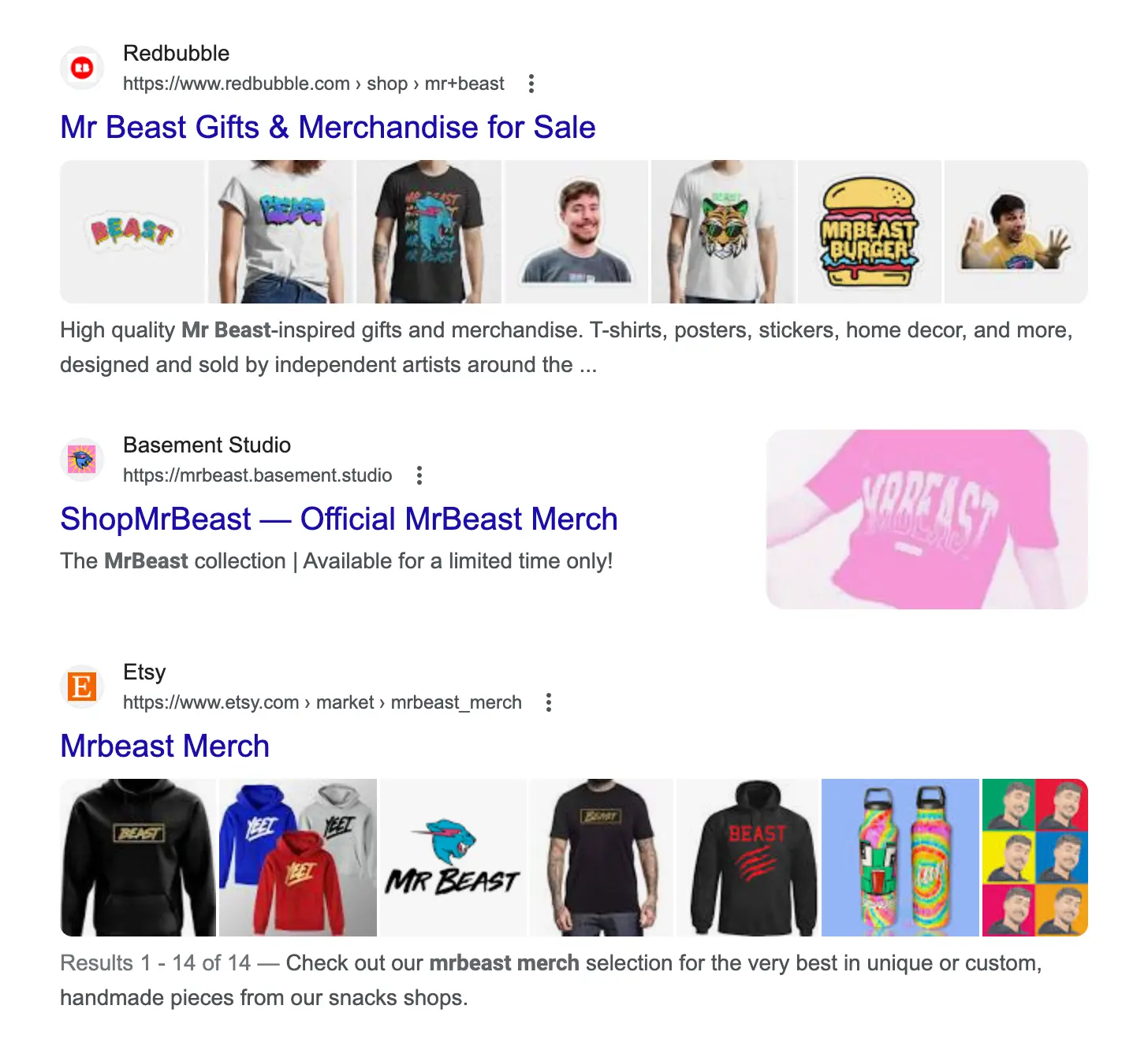Defending your Art: Safeguarding Your Merchandise Designs from Digital Counterfeits

Have you ever seen your original merchandise designs end up on other people's stores on sites like Redbubble, Etsy, Shopify, or Amazon? It's a growing issue where someone rips off creative designs and tries to make a quick buck by advertising on Google Ads and Facebook. It's a real problem: it robs creators of their potential sales and cheapens their original work.
As an example, there are 1000s of presumably counterfeit products if you Google search for MrBeast’s store:

If you’re a creator or musician with a YouTube channel, Instagram page, or podcast, you’ve likely suffered from the same experience. Counterfeit goods are as old as branding itself. Even today, it’s estimated that over $600 billion in counterfeit goods are sold every year. The online creator space is, unsurprisingly, a market as vulnerable to this practice as any other.
So what can creators do to protect themselves? In this article, we're going to tackle this issue head-on and discuss how you, as a creator, can use certain legal tools to protect your designs and your business.
Why Legal Assistance Matters in Intellectual Property Cases
It's not fair when someone takes your stuff without asking. It’s especially unfair when that rip off is a lower quality product than what you’d normally offer your fans on a platform like Fourthwall. From a legal perspective, counterfeiters cannot typically make unauthorized use of your trademarks, your copyrights, or your creative work without your permission.
When reading the analysis that follows, please keep in mind that intellectual property is a complex area of law, and there are many, many factors and issues to consider that are not addressed in this article. For example, in certain circumstances, sending a cease-and-desist letter can actually weaken a creator’s legal claims. In others, sending a DMCA takedown notice can sometimes expose the sender to liability. This article is meant to give a brief overview of your options, but you should always consult with your lawyers first.
With that important disclaimer out of the way, let’s dive in. We’ll discuss cease-and-desist letters first and then touch on DMCA takedown notices.
Navigating the Legal Path: Cease-and-Desist Letters
Sending a cease-and-desist letter is often the first step a trademark owner takes in response to suspected third-party infringement or misuse. The goal of this letter, put simply, is to cause the infringing party to stop infringing (and to avoid costly litigation).
Here are some guidelines on when and how to send a cease-and-desist letter:
- Identify the infringement: Before sending a cease-and-desist letter, identify the infringing activity, such as the unauthorized use of your trademark. Collect evidence, such as screenshots and URLs, that supports your claim.
- Draft the letter: The letter should include a clear and concise statement of your rights, the infringing activity and a demand that the third party immediately cease such activity. The letter may also include a deadline for compliance and a warning of legal action if the infringing activity continues.
- Send the letter: The letter should be sent to the infringing party via certified mail with return receipt requested. Keep a copy of the letter for your records.
An example of a cease-and-desist letter is provided for your reference here. If the misuse or infringing activity is not resolved as a result of the cease-and-desist letter, the next step to consider is taking the fight to court. The goal of the cease-and-desist letter, however, is to avoid court entirely as well as the expensive legal fees inherent in litigation.
Taking Down Counterfeiters with DMCA Notices
Another potential approach, in the event of copyright infringement, is to send a notice under the Digital Millennium Copyright Act (referred to as a “DMCA takedown notice”). Under the DMCA, online service providers can be held responsible for copyright infringement that occurs on their platform unless they respond appropriately to a DMCA takedown notice.
To request that a service provider like Redbubble, Etsy, Amazon, or any other removes infringing copyrighted material, you can submit a takedown notice to the service provider that follows the DMCA guidelines. An example of such a letter is available here. Many platforms have a “dmca@” email address or submission form that you can upload such a takedown letter to.
A DMCA takedown notice can be utilized instead of or in addition to a cease-and-desist letter (though note that the cease-and-desist letter discussed above addresses trademark infringement and should be sent to the infringing party, whereas the DMCA is specific to copyright infringement and should be sent to the platform service provider).
















